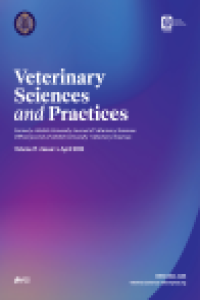Kaşar Peyniri Üretiminde Laktik Asit, Asetik Asit, Sitrik Asit ve Glucano Delta Lakton Kullanılması
Ön asitlendirme, GDL, Kaşar peyniri
Lactic Acid, Acetic Acid, Citric Acid and Glucono-delta-lactone Treatments of Milk Used in Kashar Cheese Manufacture
Pre-acidification, GDL, Kashar cheese,
___
- American Public Health Association (APHA), 1974. Standard methods for the Examination of Dairy Products. 13th ed. Washington,
- American Public Health Association (APHA), 2001. Microbiological Examination of Foods. 4th ed. Washington,
- Asker, AA., Gaafar, RM., Magdoub, MN., Shehata, AE., 1982. Manufacture of Domiati cheese by direct acidification method. Egypt. J. Dairy Sci., 10, 61.
- British Standard, 1963. Methods fort he chemical analysis of cheese. 8th ed., British standard Inst., London, BS 770.
- Doesburg B. 2006. Strong performance by weak acids: How to keep your foods safe and sharp. Food Safety, 50-54.
- Downs, PA., 1955. Judging Quality in Dairy Products. Exp. Station Cir. 54, Univ. of Nebraska.
- Elmacı, Y., 2001. Gıda Katkı maddeleri. Editör Altuğ, T., Meta Basım, İzmir.
- Fernandez, A., Kosikowski FV., 1985. Pyhsical Properties of direct acidified mozzarella cheese from ultrafiltered whole milk retentates. J. Dairy Sci., 69, 643-648.
- Ghosh, BC., Kulkarni, S., 1996. Low cholesterol Mozzeralla cheese. J. Food Tech., 3, 488- 492.
- Guler, Z., Uraz, T., 2004. Correlations in flavour and chemical parameters of Kasar cheeses. Milchwissenschaft, 59, 149-154.
- Halkman, AK., Halkman, Z., 1991. Studies on the different combinations of kashar cheese starter cultures. Gıda, 16: 99–105.
- Harrigan, WF., 1998. Laboratory Methods in Food London, Academic Press.
- Hirschl, R., 1975. Manufacture of Queso Blanco using acid whey concentrates as coagulants. M.S. Thesis, Cornell Univ., Ithaca, NY.
- International Dairy Federation (IDF), 1981. Sensory evaluation of dairy products. IDF, Brussels, IDF No:99A.
- International Dairy Federation (IDF), 1991, Routine Methods for Determination of Free Fatty Acid in Milk. Bulletin of the IDF, No: 265, p 26-32.
- Kaminarides SE., Siaravas V., Potetsianaki I. 1995. Comparison of 2 methods of making kneaded plastic cheese from ewe’s milk. Lait, 75, 181–189.
- Keçeli, T., Sahan, N., Yaşar, K., 2006. The effect of pre-acidification with citric acid on reduced-fat kashar cheese. Aust. J. Dairy Technol., 61, 32-36.
- Keles, A., Dogruer, Y., Ucar, G., Guner, A., 2003. Preacidification treatments of milk used in halloumi Alimentaria 32, 257-267. Acta
- Kosikowski, FV., Mistry, VV., 1997. Cheese and Fermented Milk Foods. Volüme 1. Third Edition, Michegan, US, p 728.
- Metzger, LE., Barbano, DM., Rudan, MA., Kindstedt, PS., 2000. Effect of milk pre- acidification on low fat Mozzarella cheese. I. Composition and yield. J. Dairy Sci., 83:648–658.
- Nelson, JA., Trout, GM., 1948. Judging Dairy Products. 2 nd ed., Olsen Publ. Co., Wisconsin, pp 434.
- Shehata, AE., Lyer, M., Olson, NF., Richardson, T., 1967. Effect of type of acid used in direct acidification firmness and calcium levels of cheese. J. Dairy Sci. 50, 6, 824. on moisture,
- Siapantas, L., 1981. Flavor profile of Queso Blanco. The quality of foods and beverages. Chem. Technol. 1. 327.
- Tarakci, Z., Kucukoner, E., 2006. Changes on physicochemical, lipolysis and proteolysis of vacuumpacked during ripening. Journal of Central European Agriculture, 7, 459-464. Kashar cheese
- Tekinşen, OC., 2000. Süt Ürünleri Teknolojisi. Selçuk Üniversitesi Basımevi, Konya.
- Başlangıç: 2022
- Yayıncı: Atatürk Üniversitesi
Korhan ÖZTURAN, Cemal ÜNSAL, Yakup KARAKAYA, Mustafa ATASEVER, Ziya Gökalp CEYLAN, Meryem Aydemir ATASEVER, A. Kürşat DEMİRKAYA
Kaşar Peyniri Üretiminde Laktik Asit, Asetik Asit, Sitrik Asit ve Glucano Delta Lakton Kullanılması
Mustafa ATASEVER, Ziya Gökalp CEYLAN, Gülşah ÇANAKÇI, İsmail ATASEVER
